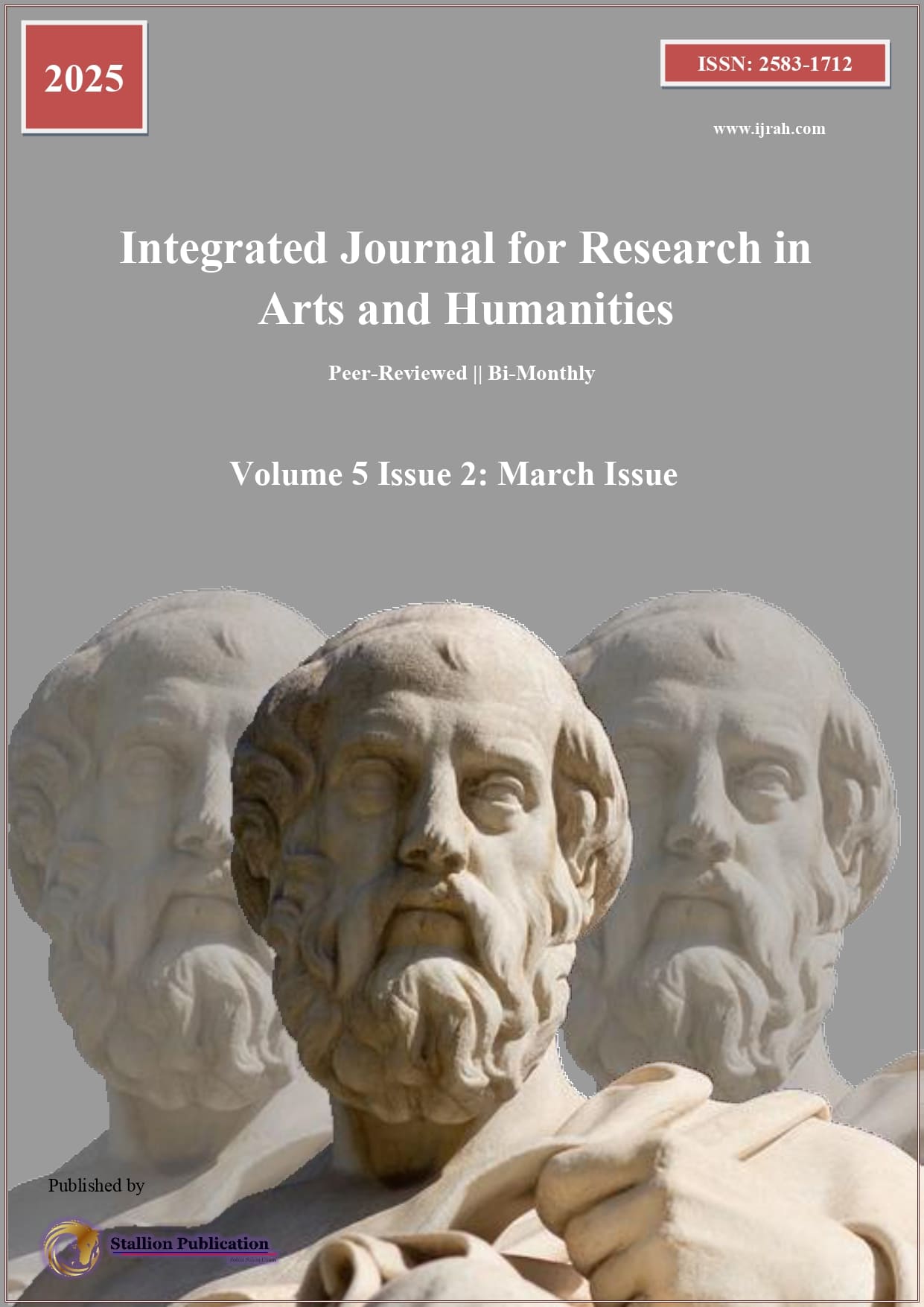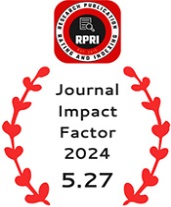From Learning Style to E-Learning Style: A Paradigm Shift in Digital Era
DOI:
https://doi.org/10.55544/ijrah.5.2.41Keywords:
Learning Style, E-Learning Style, Paradigm Shift, Digital Era, Online EducationAbstract
The swift progression of digital technologies has sparked a revolutionary change in educational paradigms, displacing conventional learning approaches with virtual learning environments. This paper, titled "From Learning Style to e-learning style: A Paradigm Shift in the Digital Era," explores the implications, challenges, and opportunities presented by this transition. For many years, educational techniques have been led by models such as VARK and Kolb which categorise traditional learning patterns. These approaches have been redefined by the use of information and communication technology (ICT) in education, which makes use of digital technologies to provide more individualised and interactive learning opportunities. This study looks at the factors that have caused this change, such as changes in learner demographics, technology improvements, and the effects of major world events like the COVID-19 epidemic. It draws attention to the advantages of online learning, including its improved flexibility, accessibility, and ability to foster interaction through multimedia resources. The study also discusses the difficulties brought about by the digital divide and the necessity of professional development for teachers. The research highlights the efficacy of ICT interventions in enhancing educational results for varied learner groups by examining case studies and real-world applications. The results indicate that although e-learning has many benefits, overcoming its obstacles and reaching its full potential will take a coordinated effort. In order to build inclusive and productive e-learning environments in the digital era, stakeholders are given guidelines in the paper's conclusion.
Downloads
References
Alamsyah, D., Indriana, Setyawati, I., & Rohaeni, H. (2022). New technology adoption of e-learning: Model of perceived usefulness. In 2022 3rd International Conference on Big Data Analytics and Practices (IBDAP) (pp. 79-84). IEEE. https://doi.org/10.1109/IBDAP55587.2022.9907261
Aksoy, N., & Üstündağ, M. T. (2023). Classification of e-learning styles in online learning environment. Journal of Educational Technology and Online Learning. https://doi.org/10.31681/jetol.1332297
Babak, E. (2023). Ecology of e-learning. Educational Challenges. https://doi.org/10.34142/2709-7986.2023.28.1.04
Brika, S., Chergui, K., Algamdi, A., Musa, A., & Zouaghi, R. (2022). E-learning research trends in higher education in light of COVID-19: A bibliometric analysis. Frontiers in Psychology, 12. https://doi.org/10.3389/fpsyg.2021.762819
Cappel, J. J., & Hayen, R. (2004). Evaluating e-learning: A case study. Journal of Computer Information Systems, 44(4), 49-56. https://doi.org/10.1080/08874417.2004.11647567
Chen, B., Shen, C., Ma, G., Zhang, Y., & Zhou, Y. (2011). The evaluation and analysis of student e-learning behavior. 2011 10th IEEE/ACIS International Conference on Computer and Information Science (pp. 244-248). IEEE. https://doi.org/10.1109/ICIS.2011.46
Chikileva, L., Chistyakov, A., Busygina, M., Prokopyev, A., Grib, E. V., & Tsvetkov, D. N. (2023). A review of empirical studies examining the effects of e-learning on university students' academic achievement. Contemporary Educational Technology. https://doi.org/10.30935/cedtech/13418
Coltey, M., Davis, M., & Walker, K. (2021). Generalized structure for adaptable and immersive learning. Educational Technology & Society, 24(1), 105-118. https://doi.org/10.1016/j.compedu.2020.103801
Fu, X. (2021). Research on teaching model of animation professional class based on online learning platform. Journal of Physics: Conference Series, 1852(1), 012134. https://doi.org/10.1088/1742-6596/1852/1/012134
Gligorea, L., Heller, K., & Simionescu, L. (2023). Learning using artificial intelligence: E-learning as a solution for personalized learning. Procedia Computer Science, 200, 405-412. https://doi.org/10.1016/j.procs.2022.12.053
Hamada, M. (2012). A learning style model for e-learning systems. Journal of Educational Technology & Society, 15(4), 15-30. https://doi.org/10.1109/IJKT.2012.34
Heard, J. (2019). Converting traditional learning to online environments. Educational Technology Research and Development, 67(2), 295-313. https://doi.org/10.1007/s11423-018-9615-3
Horváth, L. (2021). Analysis of personalized learning opportunities in adaptive learning systems. Computers & Education, 163, 104097.
Johnson, L., Becker, S. A., Estrada, V., & Freeman, A. (2011). Adoption of e-learning support for teaching: A multiple case study. Educause Review, 46(6), 20-34. https://doi.org/10.1016/j.compedu.2011.03.013
Kassim, H., Daud, M., & Jusoff, K. (2010). E-learning among academics: Motivations and cognitive style. International Journal of Computer Applications in Technology, 42(1), 66-73. https://doi.org/10.1504/IJCAT.2010.030403
[1:20 PM, 6/6/2024] Jio: Katsaris, I., & Vidakis, N. (2021). Adaptive e-learning systems through learning styles: A review of the literature. Advances in Mobile Learning Educational Research, 1(2), 49-58. https://doi.org/10.25082/amler.2021.02.007
Kolb, D. A. (1984). Experiential learning: Experience as the source of learning and development. Prentice Hall.
[1:20 PM, 6/6/2024] Jio: Komala, A. (2021). Impact of e-learning on student learning motivation. Journal of Education and Learning, 10(1), 25-34. https://doi.org/10.5539/jel.v10n1p25
Kumar, G., & Kushwaha, A. (2018). E-learning vs. traditional learning: A review. Journal of Education and Learning, 7(2), 56-62. https://doi.org/10.5539/jel.v7n2p56
[1:20 PM, 6/6/2024] Jio: Lara, J., Aljawarneh, S. A., & Pamplona, S. (2020). Special issue on the current trends in e-learning assessment. Journal of Computing in Higher Education, 32(1), 1-8. https://doi.org/10.1007/S12528-019-09235-W
López-Belmonte, J., Segura-Robles, A., Moreno-Guerrero, A.-J., & Parra-González, M. (2021). Projection of e-learning in higher education: A study of its scientific production in Web of Science. European Journal of Investigation in Health, Psychology and Education, 11(1), 20-32. https://doi.org/10.3390/ejihpe11010003
[1:20 PM, 6/6/2024] Jio: McGuinness, C., & Fulton, C. (2019). Digital literacy in higher education: A case study of student engagement with e-tutorials using blended learning. Journal of Information Literacy, 13(2), 16-37. https://doi.org/10.11645/13.2.2520
Mohr, A. T., Holtbrügge, D., & Berg, N. (2012). Learning style preferences and the perceived usefulness of e-learning. Teaching in Higher Education, 17(3), 309-322. https://doi.org/10.1080/13562517.2011.640999
Mukhopadhyay, K. (2021). E-learning and motor relearning programme in physical education. International Journal of Advanced Research in Science, Communication and Technology, 10, 35-45. https://doi.org/10.48175/ijarsct-1758
Mulyati, S. (2023). The use of technology in teaching and learning English through e-learning for students college. PPSDP International Journal of Education, 2(2), 23-30. https://doi.org/10.59175/pijed.v2i2.145
Osadchyi, V., Anane, R., & Hendley, R. (2020). A model of learning based on capabilities and augmented reality. International Journal of Interactive Mobile Technologies, 14(1), 123-135. https://doi.org/10.3991/ijim.v14i01.11702
Papoutsi, F. A., & Rangoussi, M. (2020). Pedagogical agents in e-learning: A review of recent (2009-2019) research results. Proceedings of the 24th Pan-Hellenic Conference on Informatics. https://doi.org/10.1145/3437120.3437332
Purwasih, D., Wilujeng, I., Jumadi, & Wahyuni, T. (2022). Development of e-modules based on learning style to facilitate study during pandemic. Proceedings of the 2022 13th International Conference on E-Education, E-Business, E-Management, and E-Learning. https://doi.org/10.1145/3514262.3514277
Rakic, S., Tasić, N., Marjanović, U., Softic, S., Lüftenegger, E., & Turcin, I. (2020). Student performance on an e-learning platform: Mixed method approach. International Journal of Emerging Technologies in Learning, 15(2), 187-203. https://doi.org/10.3991/ijet.v15i02.11646
Logan, R., Johnson, C. E., & Worsham, J. W. (2020). Development of an e-learning module to facilitate student learning and outcomes. Teaching and Learning in Nursing. https://doi.org/10.1016/j.teln.2020.10.007
Maaliw, R. R. (2021). A personalized virtual learning environment using multiple modeling techniques. In 2021 IEEE 12th Annual Ubiquitous Computing, Electronics & Mobile Communication Conference (UEMCON) (pp. 0008-0015). IEEE. https://doi.org/10.1109/uemcon53757.2021.9666645
Mukhopadhyay, K. (2021). E-learning and motor relearning programme in physical education. International Journal of Advanced Research in Science, Communication and Technology. https://doi.org/10.48175/ijarsct-1758
Patil, D. U., & Chandankhede, S. A. (2022). E-learning in education. International Journal of Advanced Research in Science, Communication and Technology. https://doi.org/10.48175/ijarsct-7407
Prakash, J. (2021). E-learning and its impact on students and their learning styles. The Journal of Contemporary Issues in Business and Government, 27(3), 640-644. https://doi.org/10.47750/CIBG.2021.27.03.086
Raj, S. (2021). A comprehensive study on learning styles, e-learning model and tools. Turkish Journal of Computer and Mathematics Education, 12(10), 2504-2510. https://doi.org/10.17762/TURCOMAT.V12I10.4862
Santoso, H., Hadi Putra, P. O., & Farras Hendra, F. (2021). Development & evaluation of e-learning module based on visual and global preferences using a user-centered design approach. International Journal of Emerging Technologies in Learning (iJET), 16(15). https://doi.org/10.3991/ijet.v16i15.24163
Sihombing, J. H., Laksitowening, K. A., & Darwiyanto, E. (2020). Personalized e-learning content based on Felder-Silverman learning style model. In 2020 8th International Conference on Information and Communication Technology (ICoICT) (pp. 1-6). IEEE. https://doi.org/10.1109/ICoICT49345.2020.9166452
Tanjga, J. (2023). E-learning: A review of current practices and future directions. International Journal of Learning Technology. https://doi.org/10.1504/IJLT.2023.10041530
Tunmibi, S., Aregbesola, A., & Asani, E. (2015). The impact of e-learning and digitalization in primary and secondary schools. Journal of Education and Practice, 6(17), 53-58. https://consensus.app/papers/impact-elearning-digitalization-primary-secondary-tunmibi/fc4b32eb58245f7c867c45c168ea6995
Ucar, D., & Yilmaz, S. (2023). Pre-service science teachers’ e-learning styles. Journal of Baltic Science Education. https://doi.org/10.33225/jbse/23.22.167
Valverde-Berrocoso, J., Garrido-Arroyo, M. C., Burgos-Videla, C., & Morales-Cevallos, M. B. (2020). Trends in educational research about e-learning: A systematic literature review (2009–2018). Sustainability, 12(12), 5153. https://doi.org/10.3390/su12125153
Wen, J., & Lin, Z. (2008). Ways and means of employing technology in e-learning systems. Journal of Educational Technology Development and Exchange, 1(1), 33-46. https://consensus.app/papers/ways-means-employing-technology-elearning-systems-wen/4687393b8b285df283f94e263b240082
Wong, K. S., & Sixl-Daniell, K. (2015). A case study in corporate e-learning. Corporate Training and Development Journal, 26(4), 45-60. https://consensus.app/papers/case-study-corporate-elearning-wong/add64c081df8516780895ff1d616382d
Xie, X., & Xue, W. (2022). A study of e-learning style. In 2022 IEEE 6th Information Technology and Mechatronics Engineering Conference (ITOEC) (pp. 1563-1571). IEEE. https://doi.org/10.1109/ITOEC53115.2022.9734717
Xie, X., & Xue, W. (2022). A measurement of online-learning style based on a modified model. In 2022 IEEE 10th Joint International Information Technology and Artificial Intelligence Conference (ITAIC) (pp. 2091-2101). IEEE. https://doi.org/10.1109/ITAIC54216.2022.9836840
Yeap, E. Y. L., Lim, K. C., Faudzi, M. A., Mohamed Zabil, M. H., Omar, R., Selamat, A., & Krejcar, O. (2022). A systematic review on English language e-learning technologies. In 2022 IEEE International Conference on Computing (ICOCO) (pp. 380-385). IEEE. https://doi.org/10.1109/ICOCO56118.2022.10031709
Yilmaz, S., & Ucar, D. (2023). Pre-service science teachers’ e-learning styles. Journal of Baltic Science Education, 22(1), 167-177. https://doi.org/10.33225/jbse/23.22.167
Yu, Z., & Wang, W. (2021). A systematic review of the effectiveness of flipped classroom in K-12 science education. Educational Technology & Society, 24(1), 62-77. https://doi.org/10.1007/s11423-021-09992-4
Zhang, D., Zhao, J., Zhou, L., & Nunamaker, J. F. (2004). Can e-learning replace classroom learning? Communications of the ACM, 47(5), 75-79. https://doi.org/10.1145/986213.986216
Zualkernan, I. A., & Allert, J. (2005). Adaptive e-learning environments for novice programmers. Computers & Education, 44(1), 33-42. https://doi.org/10.1016/j.compedu.2003.11.004
Downloads
Published
How to Cite
Issue
Section
License
Copyright (c) 2025 Diksha Dhanda

This work is licensed under a Creative Commons Attribution-NonCommercial-NoDerivatives 4.0 International License.




















